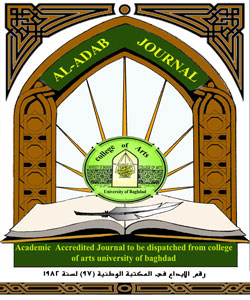فلسفة الفجوات الاستفهامية في المحكي الروائي العراقي بعد 2003م
DOI:
https://doi.org/10.31973/aj.v2i139.2616الكلمات المفتاحية:
الفجوات، الفراغات، المحكيات، الروايةالملخص
تعد الفجوات السردية الاستفهامية في النصوص الروائية من التقانات المهمة في جذب القارئ وإثارته وزيادة رغبته للقراءة، إذ تبنى المحكيات الروائية على الفجوات السردية، وتقع على القارئ مسؤولية النّظر فيها حتّى يتجسد العمل الأدبيّ ويتحقق، ومما لا يمكن إغفاله، أن وجود الفجوات في النّصّ يمثل حجبا أو تأجيلا للمعرفة، مما يثير فضول القارئ في الوصول لتلك المعرفة المحجوبة أو المؤجلة، فالنص يقدم استفهامات تنتظر أجوبة، يقود الوصول إليها من القارئ لملئِها، إذ إن النص المبني على الفجوات قائم على التحاور والمُطَاوَلَة، والمحكيات السردية الروائية العراقية تمثل فضاءً سرديا واسعًا لتلك الفراغات الافتراضية، ولا سيما النتاج الروائي المتدفق بعد 2003م، بما مثلته هذه المدة الزمنية الفاصلة بكل تغيراتها السياسية والاجتماعية والثقافية، وما دامت الفجوة متعلّقة بالقارئ أكثر من ارتباطها بالنّصّ، وجب على القارئ مسؤولية الكشف عن مكان وحيّز الفجوة، ولهذا السبب ولدت فكرة البحث لرصد مكامن الفجوات الاستفهامية في المحكيات الروائية العراقية، بهدف تسليط الضوء عليها نظريا وتطبيقيا، وبيان الدور المهم والمحوري للفجوات الاستفهامية في المحكيات الروائية العراقية بعد 2003م.
التنزيلات
المراجع
Abbas, Louay Hamza. (2011). city pictures. P. 1. Arab House for Science Publishers. Beirut.
Akkad, Munqith Nader. (2012). The Structure of Narrative in the New Arabic Novel. P. 1. House of Culture and Media. Sharjah.
Al-Atwi, Abdul Ghaffar. (2014). The reader in the narration. P. 1. Rossum House. Baghdad.
Al-Hadithi, Ali (2019). Thekrat P. 1. Nineveh House. Damascus.
Al-Rawi, Shahd. (2016). Baghdad Clock. P. 2. Dar al-Hikma. London.
Al-Rubaie, Hamid. (2017). red pub. P. 1. Dar Safsafa, Giza.
Al-Shabib, Taha Hamed. (2005). Clotheslines. P. i. Al Qabas Press. Baghdad.
Al-Suhail, Raghad (2019). 17 homes. P. 1. The Arab Foundation for Studies and Publishing. Beirut.
Al-Zaidi, Falih Khudair. (2014). Questian Hotel. P. 1. Hariri House. Beirut.
Bahrawi, Hassan. (1990). The structure of the narrative form. P. 1. Arab Cultural Center. Beirut.
Bouazza, Mohamed. (2007). Narrated Hermeneutics. P. 1. Arab spread. Beirut.
Canaan, Shlomit Raymond. (1995). Narrative Fiction. P. 1. House of Culture. White House.
Derrida, Jack. (2000). Writing and difference. P. 2. Dar Toubkal. White House.
Fadel, Hamed. (2015). A town in a box. P. 1. Structure House. Baghdad.
Falak, Nassif (2015). Qiyamut. P. 1. House of Structures Baghdad.
Gabr, Muhammad Alwan. (2015). The last crutch hymns. P. 1. Alwan House and Library. Baghdad.
Gabr, Muhammad Alwan. (2018). Why do you hate Remarque.1st. Dar al-Hikma. London.
Hamdani, Hamid. (2003). Reading and semantic generation. P. 1. Arab Cultural Center. White House.
Holb, Robert. (1994). Reception theory a critical introduction. P. 1. Literary Cultural Club in Jeddah. grandmother.
Iser, Wolfgang. (2000). the act of reading. The National Translation Project. Cairo.
Iser, Wolfgang. (2006). implicit reader. P. 1. House of Cultural Affairs. Baghdad.
Judeh, Jassim Hamid. (2016). Phenomenology and symbol. P. 1. Methodology house. Oman.
Kajah Ji, Inaam (2019). American granddaughter. Jordanian Family Library. Oman.
Karmyani, Tahseen (2011). My story with a severed head. 1st Edition. The Arab Institute for Studies and Publishing. Beirut.
Mandour, Muhammad (D.T). Literature and its Doctrines. . Egypt's Renaissance House, Cairo.
Muftah, Muhammad. (2000). Text from reading to theorizing. P. 1. School Company. White House.
Musa, Abdul Muttalib Abdul Mahdi. (2016). The phenomenon of political violence. P. 1. Ghaida's house Oman.
Rahim, Saad Mohammed. (2016). The bookseller was murdered. P. 1. Structure House. Baghdad.
Saeed, Saad. (2012). Virgo. P. 1. The Arab Foundation for Studies and Publishing. Beirut.
Taha, Ibrahim. (1993). "The Gapping System and Dialogue of Reading". Carmel Magazine. (14): 95-129.
Yaqtin, Saeed. (2001). The openness of the narrative text. I 2. The Arab Cultural Center. Beirut.
التنزيلات
منشور
إصدار
القسم
الرخصة
:حقوق الطبع والنشر والترخيص
بالنسبة لجميع البحوث المنشورة في مجلة الآداب، يحتفظ الباحثون بحقوق النشر. يتم ترخيص البحوث بموجب ترخيص Creative Commons CC BY 4.0 المفتوح ، مما يعني أنه يجوز لأي شخص تنزيل البحث وقراءته مجانًا. بالإضافة إلى ذلك ، يجوز إعادة استخدام البحث واقتباسه شريطة أن يتم الاستشهاد المصدر المنشور الأصلي. تتيح هذه الشروط الاستخدام الأقصى لعمل الباحث وعرضه.
:إعادة إنتاج البحوث المنشورة من الناشرين الآخرين
من الضروري للغاية أن يحصل الباحثون على إذن لإعادة إنتاج أي بحث منشورة (أشكال أو مخططات أو جداول أو أي مقتطفات من نص) لا يدخل في نطاق الملكية العامة أو لا يملكون حقوق نشرها. يجب أن يطلب الباحثون إذنًا من مؤلف حقوق النشر (عادة ما يكون الناشر).
يطلب الإذن في الحالات التالية:
بحوثك الخاصة المنشورة من قِبل ناشرين آخرين ولم تحتفظ بحقوق النشر الخاصة بها.
مقتطفات كبيرة من بحوث أي شخص أو سلسلة من البحوث المنشورة.
استخدم الجداول والرسوم البيانية والمخططات والمخططات والأعمال الفنية إذا لم يتم التعديل عليها.
الصور الفوتوغرافية التي لا تملك حقوق لنشرها.
لا يطلب الإذن في الحالات التالية:
إعادة بناء الجدول الخاص بك مع البيانات المنشورة بالفعل في مكان آخر. يرجى ملاحظة أنه في هذه الحالة يجب عليك ذكر مصدر البيانات في شكل "بيانات من ..." أو "مقتبس من ...".
تعتبر عروض الأسعار القصيرة معقولة الاستخدام العادل ، وبالتالي لا تتطلب إذنًا.
الرسوم البيانية ، الرسوم البيانية ، المخططات ، الأعمال الفنية التي أعاد الباحث رسمها بالكامل والتي تم تغييرها بشكل ملحوظ إلى درجة لا تتطلب الاعتراف.
الحصول على إذن
لتجنب التأخير غير الضروري في عملية النشر ، يجب أن تبدأ في الحصول على أذونات في أقرب وقت ممكن. لا يمكن لمجلة الآداب نشر بحث مقتبس من منشورات أخرى دون إذن.
قد يمنحك مالك حقوق الطبع والنشر تعليمات بشأن شكل الإقرار الواجب اتباعه لتوثيق عمله ؛ بخلاف ذلك ، اتبع النمط: "مستنسخ بإذن من [المؤلف] ، [كتاب / المجلة] ؛ نشره [الناشر] ، [السنة]." في نهاية شرح الجدول ، الشكل أو المخطط.
.jpg)
























